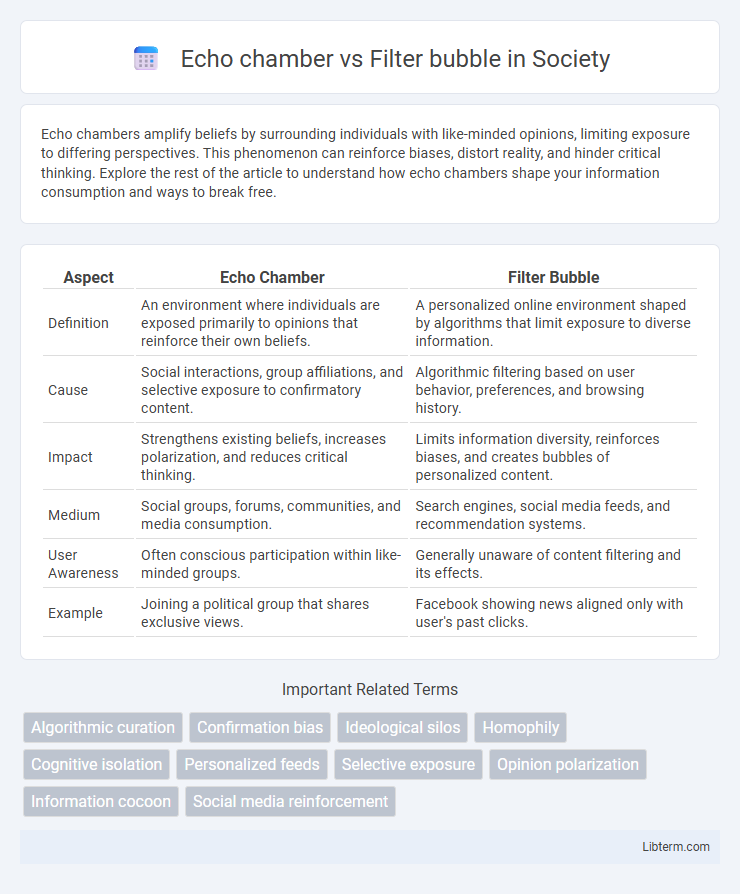Echo chambers amplify beliefs by surrounding individuals with like-minded opinions, limiting exposure to differing perspectives. This phenomenon can reinforce biases, distort reality, and hinder critical thinking. Explore the rest of the article to understand how echo chambers shape your information consumption and ways to break free.
Table of Comparison
| Aspect | Echo Chamber | Filter Bubble |
|---|---|---|
| Definition | An environment where individuals are exposed primarily to opinions that reinforce their own beliefs. | A personalized online environment shaped by algorithms that limit exposure to diverse information. |
| Cause | Social interactions, group affiliations, and selective exposure to confirmatory content. | Algorithmic filtering based on user behavior, preferences, and browsing history. |
| Impact | Strengthens existing beliefs, increases polarization, and reduces critical thinking. | Limits information diversity, reinforces biases, and creates bubbles of personalized content. |
| Medium | Social groups, forums, communities, and media consumption. | Search engines, social media feeds, and recommendation systems. |
| User Awareness | Often conscious participation within like-minded groups. | Generally unaware of content filtering and its effects. |
| Example | Joining a political group that shares exclusive views. | Facebook showing news aligned only with user's past clicks. |
Understanding Echo Chambers: Definition and Characteristics
Echo chambers are environments where individuals are exposed primarily to information and opinions that reinforce their existing beliefs, leading to amplified confirmation bias and ideological segregation. These spaces are characterized by repetitive content, homogenous viewpoints, and social echoing that limit exposure to diverse perspectives. Understanding echo chambers requires recognizing their impact on cognitive biases and the polarization of online and offline communities.
Explaining Filter Bubbles: What Sets Them Apart
Filter bubbles arise from personalized algorithms that selectively present information based on user behavior, reinforcing specific viewpoints without exposure to diverse perspectives. Unlike echo chambers, which are social environments where like-minded individuals actively share and validate similar opinions, filter bubbles operate subtly by limiting information passively through algorithmic curation. This algorithm-driven isolation intensifies confirmation bias by creating individualized content silos that restrict access to contrasting ideas and factual diversity.
Origins and Evolution of Echo Chambers and Filter Bubbles
Echo chambers originated from social psychology studies on group polarization, highlighting how like-minded individuals reinforce shared beliefs, while filter bubbles emerged from personalized algorithms in digital platforms that limit exposure to diverse information. The evolution of echo chambers is deeply rooted in human social behavior and offline interactions, whereas filter bubbles are a recent phenomenon shaped by advances in artificial intelligence and machine learning in online environments. Both concepts illustrate distinct mechanisms driving informational isolation but converge in their impact on polarization and reduced cognitive diversity.
Psychological Mechanisms Behind Information Isolation
Echo chambers reinforce existing beliefs by repeated exposure to similar opinions, triggering confirmation bias and reducing openness to contradictory information. Filter bubbles result from algorithmic personalization that limits content diversity, leading to selective exposure and cognitive dissonance avoidance. Both phenomena leverage psychological tendencies like motivated reasoning and social identity preservation, intensifying information isolation and polarizing attitudes.
Social Media Algorithms: Fueling Echo Chambers and Filter Bubbles
Social media algorithms personalize content by analyzing user behavior, prioritizing engagement over diversity, which amplifies echo chambers and filter bubbles. These algorithms reinforce existing beliefs by continuously exposing users to similar perspectives, limiting exposure to contrasting viewpoints and fostering ideological segregation. The resulting information silos diminish critical thinking and increase polarization across digital communities.
Impacts on Public Opinion and Democratic Discourse
Echo chambers intensify polarization by reinforcing existing beliefs through repetitive exposure to homogeneous viewpoints, limiting individuals' ability to engage with opposing perspectives. Filter bubbles, created by algorithmic personalization on digital platforms, selectively expose users to information aligned with their preferences, thereby narrowing the diversity of accessible content and skewing public opinion. Both phenomena undermine democratic discourse by reducing critical debate, increasing misinformation, and fostering social fragmentation.
Echo Chamber vs Filter Bubble: Key Differences
Echo chambers amplify information that aligns with existing beliefs by isolating users from opposing viewpoints through social interactions and group dynamics, leading to reinforcement bias. Filter bubbles result from algorithmic personalization on digital platforms that selectively expose users to content based on their previous online behavior, creating a narrow information diet. The key difference lies in the mechanism: echo chambers are driven by social and psychological factors, while filter bubbles are primarily caused by algorithmic content curation.
Recognizing Personal Exposure to Information Silos
Recognizing personal exposure to information silos requires understanding how echo chambers reinforce existing beliefs through repetitive content from like-minded sources, while filter bubbles algorithmically limit exposure to diverse viewpoints by tailoring information based on past behavior. Individuals can assess their media consumption patterns by analyzing the diversity of news outlets, social media interactions, and search results they engage with regularly. Using tools like media bias charts and browser extensions that reveal hidden filtering mechanisms helps identify the extent of isolation within personal information environments.
Combating Information Isolation: Strategies and Tools
Combating information isolation requires targeted strategies that address both echo chambers and filter bubbles by promoting diverse content exposure and critical thinking. Tools like algorithm transparency, personalized content controls, and cross-platform content recommendations help users break free from repetitive, biased information loops. Educational initiatives empowering media literacy strengthen users' ability to discern and seek varied viewpoints, reducing the polarizing effects of information isolation.
The Future of Online Information Consumption
Echo chambers and filter bubbles both shape the future of online information consumption by limiting exposure to diverse perspectives, but they operate differently: echo chambers involve active reinforcement within like-minded communities, while filter bubbles result from algorithmic content personalization filtering out dissenting views. Emerging technologies like AI-driven recommendation systems risk deepening these phenomena by tailoring content to user preferences, potentially narrowing information horizons and hindering critical thinking. Addressing these challenges requires developing transparent algorithms and promoting digital literacy to foster more balanced and informed online discourse.
Echo chamber Infographic

 libterm.com
libterm.com